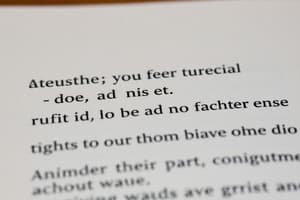Podcast
Questions and Answers
¿Qué tipo de adverbios se usan más comúnmente después del verbo que modifican?
¿Qué tipo de adverbios se usan más comúnmente después del verbo que modifican?
¿Cuál es el orden de palabras más común en las oraciones declarativas simples en inglés?
¿Cuál es el orden de palabras más común en las oraciones declarativas simples en inglés?
¿Cuál es un ejemplo de una oración en voz pasiva en inglés?
¿Cuál es un ejemplo de una oración en voz pasiva en inglés?
¿Cuáles de los siguientes adverbios pueden aparecer tanto antes como después del verbo que modifican?
¿Cuáles de los siguientes adverbios pueden aparecer tanto antes como después del verbo que modifican?
Signup and view all the answers
¿Cuál es un error común que la gente comete al colocar los adverbios en las oraciones en inglés?
¿Cuál es un error común que la gente comete al colocar los adverbios en las oraciones en inglés?
Signup and view all the answers
¿Dónde se colocan la mayoría de los adverbios en inglés?
¿Dónde se colocan la mayoría de los adverbios en inglés?
Signup and view all the answers
¿Cuál de las siguientes opciones describe mejor la función de un adverbio en una oración?
¿Cuál de las siguientes opciones describe mejor la función de un adverbio en una oración?
Signup and view all the answers
En una oración con estructura 'NP VP', ¿dónde se coloca el sujeto?
En una oración con estructura 'NP VP', ¿dónde se coloca el sujeto?
Signup and view all the answers
¿Qué tipo de elementos incluye típicamente el predicado de una oración en inglés?
¿Qué tipo de elementos incluye típicamente el predicado de una oración en inglés?
Signup and view all the answers
¿Cuál es el propósito principal de los adverbios en inglés?
¿Cuál es el propósito principal de los adverbios en inglés?
Signup and view all the answers
Study Notes
Introduction
Adverb placement is an essential component of sentence construction in the English language. Adverbs modify verbs, adjectives (which modify nouns), other adverbs, or even entire phrases. They often indicate how, when, where, why, or to what extent something happens. In this article, we will explore the role of adverbs in the English language, their structure, usage, and common misconceptions related to their placement within a sentence.
Structure of English Sentences
An English sentence consists of a subject and a predicate (or verb phrase). The subject typically identifies the person, place, thing, or idea that is performing the action described by the predicate. On the other hand, the predicate usually describes an activity, condition, or state of being. It includes one or more main verbs and any additional elements needed to express tense, mood, voice, etc.
In terms of phrase structures, there are two primary types: NP VP and S VP. An NP VP sentence has a noun phrase as its subject, while an S VP sentence begins with a sentential complement.
Adverb Placement in English Sentences
The majority of English adverbs are placed before the verb they modify. This is generally the rule for adverbs such as "quickly," "happily," "easily," or "carefully." For example, consider these sentences:
- John quickly ran down the street.
- She happily accepted the award.
- He easily solved the puzzle.
- Carefully, he folded the paper.
However, some adverbs are better suited to appear after the verb they modify; those are called postpositive adverbs. Examples include "abroad," "alongside," or "inside." For instance:
- John walked abroad.
- The dog slept alongside her.
- He put his hands inside the box.
Additionally, certain adverbs can appear both before and after the verb they modify depending on the context they're used in. These adverbs include "back," "forward," "home," "out," and "up."
Word Order in English Sentences
Word order plays a crucial role in conveying meaning in English sentences. In a simple declarative sentence, the word order typically follows the Subject-Verb-Object (SVO) pattern. For example, "The cat sat on the mat."
However, there are various sentence structures in English, such as:
- Passive: "The mat was sat on by the cat."
- Interrogative: "Did the cat sit on the mat?"
- Exclamatory: "What a beautiful cat sat on the mat!"
- Imperative: "Sit on the mat, cat!"
Common Misconceptions about English Sentences and Adverbs
Some people mistakenly believe that adverbs should always be placed at the end of a sentence, which leads to incorrect and awkward sentence structures. However, the correct placement of adverbs depends on the context and the verb they modify.
Another common misconception is that sentences must always follow the Subject-Verb-Object (SVO) pattern. While SVO is the most common sentence structure in English, there are various other structures, including passive voice, interrogative, exclamatory, and imperative sentences.
In conclusion, understanding the role of adverbs in English sentences and their correct placement is essential for effective communication. By following the guidelines provided and practicing sentence construction with a variety of sentence structures and adverb placements, one can enhance their writing skills and produce more accurate and grammatically sound sentences.
Studying That Suits You
Use AI to generate personalized quizzes and flashcards to suit your learning preferences.
Description
Explore the role of adverbs in English sentences, their structure, usage, and common misconceptions related to their placement. Learn about adverb placement before and after verbs, word order patterns like SVO, and various sentence structures in English.




